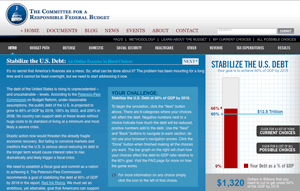Just for kicks, what programs would you scrap if you had the sole responsibility — currently held, and largely neglected, by politicians in Washington — of stabilizing the national debt?
You could reduce veterans’ income security benefits for a savings of about $50 billion over the next seven years.
Or reduce food stamp benefits ($100 billion), or federal funding for K-12 education ($60 billion), or money for the national highway system ($70 billion).
Or you could cancel all together NASA missions to the moon and Mars ($40 billion), planned subsidies to biofuels ($110 billion) and school breakfast programs ($30 billion).
This assumes, of course, that you don’t also want to do anything that will add to the debt — like enact a new jobs bill (add $210 billion), or expand federal investments in basic research and development (another $100 billion).
The entire exercise gets maddening pretty quickly, which is part of the point. Stabilizing the national debt — the most pressing challenge facing the country according to a growing chorus of wonks and economists — turns out to be much trickier than many politicians let on with their simple “waste, fraud and abuse” solutions.

Miller-McCune’s Washington correspondent Emily Badger follows the ideas informing, explaining and influencing government, from the local think tank circuit to academic research that shapes D.C. policy from afar.
To fully convey this, the bipartisan Committee for a Responsible Federal Budget has invited people to go through these programs line-by-line. They’ve built an online “exercise in hard choices,” a game about as fun as filing your taxes but probably more satisfying for anyone who finishes it.
“I have no idea what brings people in, who it is that’s willing to play a budget simulator,” said Maya MacGuineas, president of the CRFB. “All I know is that we’ve been astounded and gratified by the participation.”
Since the simulator first went online two months ago, 7,200 people have tried their hand at it. About 3,000 so far have offered to share the results of what they came up with, giving the CRFB a burgeoning collection of public-opinion data it intends to share with real-life lawmakers.
Surprisingly, many of those people actually succeeded in stabilizing the problem, or reining in debt to 60 percent of GDP by 2018. CRFB borrowed that benchmark from a recommendation by the Peterson-Pew Commission on Budget Reform, which calculated the figure as “the most ambitious yet realistic goal” we can get to in the next seven years. (For comparison: That Peterson-Pew report showed debt rising from 41 to 53 percent of GDP over the previous year alone, with projections for it to reach 85 percent by 2018 and 100 percent by 2022.)

What’s most encouraging, MacGuineas says, is that those 3,000 people who shared their answer sheets had a remarkable amount of consensus. Their top five most-common proposals were to eliminate outdated programs, reduce the size of government earmarks and farm subsidies, reform the international tax system and set the retirement age for Social Security at 68 (total savings: $430 billion).
Which brings up CRFB’s other goal with the game. MacGuineas doesn’t just want to show citizens how serious this task is — she also wants to show politicians what people say they’re willing to cut.
“It’s [about] educating the public, but also having a deep belief that the public is a lot more willing to make tough choices than Congress gives them credit for — and letting Congress know that,” she said. “It makes sense that they’re scared to make choices they think would get them kicked out of office. But if we can say a) it’s the right thing to do, and b) voters in your district are quite willing to make these choices, that makes it a lot more feasible.”
The exercise itself is not new. The CRFB, which was founded in 1981, has taken similar, paper-based “exercises in hard choices” on the road to town hall community meetings in the past. The goals then were different, though.
“We used to be thinking about how to balance the budget in five years,” MacGuineas said. “That’s just not going to happen any more, it’s out of the realm of what we can accomplish now.”





